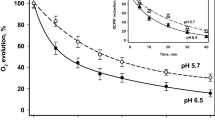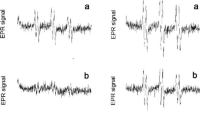Abstract
The pH-dependence of light-driven O2-reduction in intact spinach chloroplasts is studied by means of chlorophyll fluorescence quenching analysis and polarographic O2-uptake measurements. Most experiments are carried out in presence of KCN, which blocks activities of Calvin cycle, ascorbate peroxidase and superoxide dismutase. pH is varied by equilibration with external buffers in presence of nigericin. Vastly different pH-optima for O2-dependent electron flow are observed in the presence and absence of the redox catalyst methyl viologen. Both fluorescence quenching analysis and O2-uptake reveal a distinct pH 5 optimum of O2-reduction in the absence of methyl viologen. In the presence of this catalyst, O2-reduction is favoured in the alkaline region, with an optimum around pH 8, similar to other types of Hill reaction. It is suggested that in the absence of methyl viologen the extent of irreversibility of O2-reduction is determined by the rate of superoxide protonation. This implies that O2-reduction takes place within the aprotic phase of the thylakoid membrane and that superoxide-reoxidation via oxidized PS I donors competes with protonation. Superoxide protonation is proposed to occur at the internal surface of the thylakoid membrane. There is no competition between superoxide reoxidation and protonation when in the presence of methyl viologen the site of O2-reduction is shifted into the protic stroma phase. In confirmation of this interpretation, fluorescence measurements in the absence of KCN reveal, that non-catalysed O2-dependent electron flow is unique in beingstimulated by the transthylakoidal pH-gradient. On the basis of these findings a major regulatory role of O2-dependent electron flow under excess light conditions is postulated.
Similar content being viewed by others
Abbreviations
- DCMU:
-
3-(3,4-dichlorophenyl-)1,1-dimethylurea
- DAD:
-
diaminodurol
- MDA:
-
monodehydroascorbate
- MV:
-
methyl viologen
- PQ:
-
plastoquinone
References
Allen JF (1977) Superoxide and photosynthetic reduction of oxygen. In: MichelsonAM, McCordJM and FridovichI(eds) Superoxide and Superoxide Dismutases, pp 417–436. Academic Press, New York.
Anderson JW, Foyer CH and Walker DA (1983) Light-dependent reduction of hydrogen peroxide by intact spinach chloroplasts. Biochim Biophys Acta 724: 69–74.
Asada K (1992) Ascorbate peroxidase — a hydrogen peroxide-scavenging enzyme in plants. Physiol Plant 85: 235–241.
Asada K (1992) Production and scavenging of active oxygen in chloroplasts. In: Scandalios(ed) Molecular Biology of Free Radical Scavenging Systems, pp 173–192. Cold Spring Harbor Lab. Press, New York.
Asada K and Badger MR (1984) Photoreduction of18O2 and H2 18O2 with a concomitant evolution of16O2 in intact spinach chloroplasts: Evidence for scavenging of hydrogen peroxide by peroxidase. Plant Cell Physiol 25: 1169–1179.
Asada K and Takahashi M (1987) Production and scavenging of active oxygen in photosynthesis. In: KyleDJ, OsmondCB and ArntzenCJ(eds) Photoinhibition, pp 227–287. Elsevier Science Publishers, Amsterdam.
Asada K, Kiso K and Yoshikawa K (1974) Univalent reduction of molecular oxygen by spinach chloroplasts on illumination. J Biol Chem 249: 2175–2181.
Asada K, Neubauer C, Heber U and Schreiber U (1990) Methyl viologen-dependent cyclic electron transport in spinach chloroplasts in the absence of oxygen. Plant Cell Physiol 31: 557–564.
Badger MR (1985) Photosynthetic oxygen exchange. Ann Rev Plant Physiol 36: 27–53.
Bielski BHJ (1982) Chemistry of ascorbic acid radicals. In: SeibPA and TolbertBM(eds) Ascorbic Acid: Chemistry, Metabolism and Uses, pp 81–100. American Chemical Society, Washington, DC.
Böhme H and Trebst A (1969) On the properties of ascorbate photooxidation in isolated chloroplasts. Evidence for two ATP sites in non-cyclic photophosphorylation. Biochim Biophys Acta 180: 137–148.
Bradbury M and Baker NR (1981) Analysis of the slow phase of the in vivo chlorophyll fluorescence induction curve. Changes in the redox state of Photosystem II electron acceptors and fluorescence emission from Photosystem I and II. Biochim Biophys Acta 63: 542–551.
Cabelli DE and Bielski BHJ (1983) Kinetics and mechanism for the oxidation of ascorbic acid/ascorbate by HO2/O2 - radicals. A pulse radiolysis and stopped-flow photolysis study. J Phys Chem 87: 1809–1812.
Demmig-Adams P (1990) Carotenoids and photoprotection in plants: A possible role for the xanthophyll zeaxanthin. Biochim Biophys Acta 1020: 1–24.
Dietz KJ, Schreiber U and Heber U (1985) The relationship between the redox state of QA and photosynthesis in leaves at various carbon dioxide, oxygen and light regimes. Planta 166: 219–226.
Elstner EF (1982) Oxygen activation and oxygen toxicity. Ann Rev Plant Physiol 33: 73–96.
Elstner EF and Kramer R (1973) Role of superoxide free radical ion in photosynthetic ascorbate oxidation and ascorbate-mediated photophosphorylation. Biochim Biophys Acta 314: 340–353.
Epel BL and Neumann J (1973) The mechanism of the oxidation of ascorbate and Mn2+ by chloroplasts. The role of the radical superoxide. Biochim Biophys Acta 325: 520–529.
Fee JA and Valentine JS (1977) Chemical and physical properties of superoxide. In: MichelsonAM, McCordAM and FridovichI(eds) Superoxide and Superoxide Dismutases, pp 19–37. Academic Press, London.
Foyer CH and Halliwell B (1976) The presence of glutathione reductase in chloroplasts: A proposed role in ascorbic acid metabolism. Planta 133: 21–25.
Foyer CH, Rowell H and Walker D (1983) Measurement of the ascorbate content of spinach leaves protoplasts and chloroplasts during illumination. Planta 157: 239–244.
Genty B, Briantais J-M and Baker NR (1989) The relationship between the quantum yield of photosynthetic electron transport and quenching of chlorophyll fluorescence. Biochim Biophys Acta 990: 87–92.
Groden D and Beck E (1979) H2O2 destruction by ascorbate dependent systems from chloroplasts. Biochim Biophys Acta 546: 426–435.
Heber U and Walker D (1992) Concerning a dual function of coupled cyclic electron transport in leaves. Plant Physiol (1992) 100: 1621–1626.
Hossain MA and Asada K (1984) Purification of dehydro-ascorbate reductase from spinach and its characterization as a thiol enzyme. Plant Cell Physiol 25: 85–92.
Hossain MA, Nakano Y and Asada K (1984) Monodehydro-ascorbate reductase in spinach chloroplasts and its participation in regeneration of ascorbate for scavenging hydrogen peroxide. Plant Cell Physiol 25: 385–395.
Klughammer C (1992) Entwicklung und Anwendung neuer absorptions-spektroskopischer Methoden zur Charakterisierung des photosynthetischen Elektronentransports in isolierten Chloroplasten und intakten Blättern. Doctoral Thesis, Würzburg University.
Krause GH and Weis E (1991) Chlorophyll fluorescence and photosynthesis: The basics. Annu Rev Plant Physiol Plant Mol Biol 42: 313–319.
Krieger A, Moya I and Weis E (1992) Energy-dependent quenching of chlorophylla fluorescence: Effect of pH on stationary fluorescence and picosecond-relaxation kinetics in thylakoid membranes and Photosystem II preparations. Biochim Biophys Acta 1102: 167–176.
Miyake C and Asada K (1992) Thylakoid-bound ascorbate peroxidase in spinach chloroplasts and photoreduction of its primary oxidation product monodehydroascorbate radicals in thylakoids. Plant Cell Physiol 33: 541–553.
Nakano Y and Asada K (1980) Spinach Chloroplasts scavenge hydrogen peroxide on illumination. Plant Cell Physiol 21: 1295–1307.
Neubauer C and Schreiber U (1989) Photochemical and non-photochemical quenching of chlorophyll fluorescence induced by hydrogen peroxide. Z Naturforsch 44c: 262–270.
Neubauer C and Yamamoto HY (1992) Mehler-peroxidase reaction mediates zeaxanthin formation and zeaxanthin-related fluorescence quenching in intact chloroplasts. Plant Physiol 99: 1354–1361.
Oberhuber W, Dai Z-Y and Edwards GE (1993) Light dependence of quantum yields of Photosystem II and CO2 fixation in C3 and C4 plants. Photosynth Res 35: 265–274.
Quick WP and Horton P (1984) Studies on the induction of chlorophyll fluorescence in barley protoplasts. II. Resolution of fluorescence quenching by redox state and the transthylakoid pH gradient. Proc R Soc Lond B 220: 371–382.
Reising H and Schreiber U (1992) Pulse-modulated photoacoustic measurements reveal strong gas-uptake component at high CO2-concentrations. Photosynth Res 31: 227–238.
Robinson JM (1988) Does O2 photoreduction occur within chloroplasts in vivo? Physiol Plant 72: 666–680.
Schapendonk AHCM, Hemrika-Wagner AM, Theuvenet APR, Wong Fong Sang HW, VredenbergWJ and KraayenhofR (1980) Energy-dependent changes of the electrokinetic properties of chloroplasts. Biochemistry 19: 1922–1927.
Schreiber U and Bilger W (1987) Rapid assessment of stress effects on plant leaves by chlorophyll fluorescence measurements. In: TenhunenJD(ed) Plant Response to Stress, pp 27–53. Springer-Verlag, Berlin, Heidelberg.
Schreiber U and Neubauer C (1990) O2-dependent electron flow, membrane energization and the mechanism of non-photochemical quenching of chlorophyll fluorescence. Photosynth Res 25: 279–293.
Schreiber U, Schliwa U and Bilger W (1986) Continuous recording of photochemical and non-photochemical chlorophyll fluorescence quenching with a new type of modulation fluorometer. Photosynth Res 10: 51–62.
Schreiber U, Reising H and Neubauer C (1991) Contrasting pH optima of light-driven O2- and H2O2-reduction in spinach chloroplasts as measured via chlorophyll fluorescence quenching. Z Naturforsch 46c: 173–181.
Schreiber U, Bilger W and Neubauer C (1993) Chlorophyll fluorescence as a non-intrusive indicator for rapid assessment of in vivo photosynthesis. Ecological Studies 100 (in press).
Seaton GGR and Walker DA (1990) Chlorophyll fluorescence as a measure of photosynthetic carbon assimilation. Proc R Soc Lond B 242: 29–35.
Siggel U (1974) The control of electron transport by two pH-sensitive sites. In: AvronM(ed) Proceedings of the II. International Congress on Photosynthesis, pp 645–654. Rehovot, Israel. Elsevier, Amsterdam.
Takahashi M and Asada K (1983) Superoxide anion permeability of phospholipid membranes and chloroplast thylakoids. Arch Biochem Biophys 226: 558–566.
Takahashi M and Asada K (1988) Superoxide production in aprotic interior of chloroplast thylakoids. Arch Biochem Biophys 267: 714–722.
Takahashi M, Kono Y and Asada K (1980) Reduction of plastocyanin with O2 - and superoxide dimutase-dependent oxidation of plastocyanin by H2O2. Plant Cell Physiol 21: 1431–1438.
Tanaka K, Takahashi M and Asada K (1978) Isolation of monomeric cytochromef from japanese radish and a mechanism of autoreduction. J Biol Chem 253: 7397–7403.
Walker D (1992) Excited leaves. New Phytol 121: 325–345.
Weis E and Berry J (1987) Quantum efficiency of Photosystem II in relation to energy-dependent quenching of chlorophyll fluorescence. Biochim Biophys Acta 894: 198–208.
Wraight CA, Kraan GPB and Gerrits NM (1972) The pH dependence of delayed and prompt fluorescence in uncoupled chloroplats. Biochem Biophys Acta 283: 259–267.
Author information
Authors and Affiliations
Rights and permissions
About this article
Cite this article
Hormann, H., Neubauer, C., Asada, K. et al. Intact chloroplasts display pH 5 optimum of O2-reduction in the absence of methyl viologen: Indirect evidence for a regulatory role of superoxide protonation. Photosynth Res 37, 69–80 (1993). https://doi.org/10.1007/BF02185440
Received:
Accepted:
Issue Date:
DOI: https://doi.org/10.1007/BF02185440




